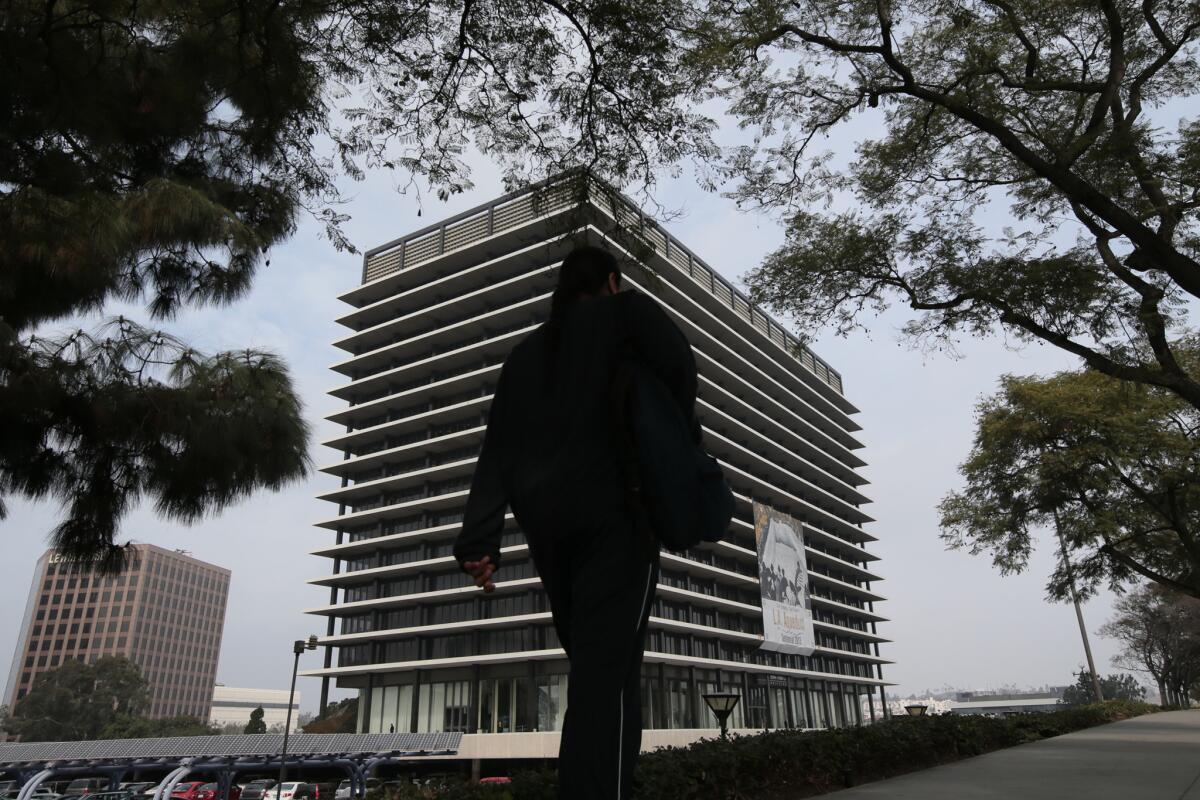DWP’s unlimited sick pay policy costs millions

- Share via
Los Angeles’ Department of Water and Power has paid thousands of employees a total of $35.5 million since 2010 in extra sick days under an unusual program that the utility’s top executive acknowledges has been vulnerable to abuse.
DWP employees benefit from a 32-year-old policy that allows them to take paid days off well beyond the agency’s 10-day-a-year cap on sick days. Last year, 10% of the department’s roughly 10,000 employees took at least 10 extra days off, the data show. More than 220 took an extra 20 working days off, or about a month, according to a Times examination of data obtained under the California Public Records Act.
In fact, records and interviews show, there is no limit to the paid time off DWP employees can take when they say they’re sick, and requirements to provide medical proof of their illness have been loosely enforced.
After reviewing data compiled for The Times, DWP Executive Director Ron Nichols said this week that “there appear to be some people who are abusing [the policy].” But he stressed that the average DWP employee takes only 4.4 sick days per year, about the same as the national average.
High compensation for DWP employees — who receive about 50% more pay than other city employees, and 25% more than employees at other area utilities — emerged as a central issue in the recent mayoral campaign, after their union became the biggest contributor to the losing effort to elect Wendy Greuel.
Mayor Eric Garcetti and other officials on the city’s employee relations committee are scheduled to discuss a new DWP contract Friday. The city-owned utility provides electricity and water to Los Angeles businesses and nearly 4 million residents.
Fred Pickel, the city’s ratepayer advocate who analyzes DWP operations, said the department’s high salaries have allowed it to attract good workers.
“You’d expect a work ethic in a group like that,” he said. “Of course, there are always people who abuse.”
The records show one senior accountant averaged 49 extra sick days each year from 2010 to 2012. A security guard averaged 43 extra days. A customer service representative averaged 38 extra days. That’s roughly two months off at full pay, per year, for each of the three employees. It doesn’t include regular sick days, paid vacation days, holidays or “personal” days.
DWP officials, noting that they were not around when the sick pay policy was adopted in 1981, said they could not find a written rationale for the unlimited extra days. Since 2010, workers have taken 103,802 extra sick days, the equivalent of 415 years.
Here’s how the policy works: The first two days an employee calls in sick are subtracted from his or her allotment of sick days. But if the employee chooses, he or she can take the next eight consecutive work days off, at full pay, without further depleting the sick day supply. No doctor’s note is required for those additional days, which are “on the house,” said one DWP executive who spoke on condition of anonymity because he was not authorized to address the media.
If the employee suffers a relapse of the same illness within 21 days of returning to work, he or she can then take an unlimited number of days off. Again, no days are subtracted from the employee’s sick day supply.
Relapses are supposed to be verified with a doctor’s note, said DWP spokesman Joe Ramallo.
But a department review of 150 employees who took the most extra days off found 67 — fewer than than half — “who appear to have bona fide chronic illnesses, who have doctor’s notes,” Nichols said.
The sick pay data provided to The Times included employees’ job title, the number of extra sick days taken and the amount the employee was paid for those days. The department refused to provide the employees’ names, citing a city attorney’s determination that the records constitute “confidential medical information” and are therefore exempt from disclosure.
Employees across job classifications have taken extra sick days, with the most frequent use among customer service representatives, whose average pay last year was $70,839.
They took 4,632 extra days in 2012 and were paid $1.3 million for that time.
About 35% of them took no extra days, but the remainder averaged 11 extra days off.
One customer service employee took an extra 56 sick days. Two took 50 days each, the data show.
Customer service is “a difficult job, you walk in every day and have customers upset at you,” Nichols said. “High absenteeism is a problem in call-centers in any industry.”
Nevertheless, managers in the department should scrutinize sick time requests more carefully, he said.
Despite some weaknesses, Nichols said, the percentage of employees who abuse the sick pay policy is very low, and he does not believe it needs to be changed. DWP officials said, in some cases, the policy has been an enormous benefit for employees suffering from serious illnesses. Brian D’Arcy, who heads the largest DWP employees union, could not be reached Thursday for comment.
Los Angeles’ chief administrative officer, Miguel Santana, said the simplest way to curb abuse would be for the DWP to follow the City Hall policy of requiring a doctor’s note for an absence longer than three days.
“I’m sure it would be subject to union negotiations, and you can always find an unethical doctor if you’re really determined,” Santana said. “But it’s something you can do that’s frankly not that complicated to control it.”
Santana said long-term absences caused by more serious illnesses are typically covered by disability programs.
In addition to the cost of full salaries for employees who aren’t working, high absenteeism has other corrosive effects on a government workplace, Santana said.
“You end up over-hiring to make up for it, the public has to deal with longer wait times when they call in, and there are morale issues because [the employees] who don’t abuse the system have to make up for the ones who do,” he said.
Officials at other government agencies said they were unaware of the DWP sick time policy and they don’t offer a comparable benefit. “Los Angeles County has nothing nearly that generous,” said spokesman David Sommers.
The state and the county offer up to 12 sick days per year, but the days are subtracted from the employees’ allotment as they are used.
City of Los Angeles employees also get 12 sick days per year.
If they don’t use them, the days can accumulate over the course of their career and the employee can receive a check at retirement for up to 50 of those unused days. The average size of that check for civilian employees was $10,583 in 2013, Santana said.
DWP employees get five sick days per year, and can accumulate up to 10 for use in any one year. They are paid for up to five days of unused sick time at the end of each year, rather than accumulating them for a lump sum payout.
jack.dolan@latimes.com
More to Read
Sign up for Essential California
The most important California stories and recommendations in your inbox every morning.
You may occasionally receive promotional content from the Los Angeles Times.














